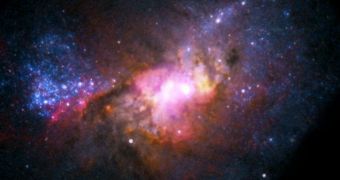A recent series of observations has revealed more details about how black holes formed in the early Universe, when the massive galaxies we see today were not yet formed. The data were collected by analyzing Henize 2-10, a dwarf starburst galaxy.
The cosmic structure is estimated to lie about 30 million light-years away, in the direction of the constellation Pyxis. The observations were conducted using the Advanced CCD Imaging Spectrometer (ACIS) instrument aboard the NASA Chandra X-ray Observatory.
According to astronomers, the study may also help them get a better understanding of how black hole growth early on assisted the growth of galaxies. At this point, it's still uncertain which phenomenon triggered the other, and a number of competing theories exist to explain this issue.
The most impressive discovery made within Henize 2-10 is the existence of an actively-growing supermassive black hole. The object was identified when experts noticed that a powerful X-ray source they observed within the starburst galaxy coincided with a radio sources other studies had discovered.
Recent investigations demonstrated that black holes can release both these types of radiation. Other than a black hole, there is really no type of cosmic object that could emit in these wavelengths at the same time, Daily Galaxy reports.
In the attached view, Chandra data are colored purple. Red, green and blue segments are data collected by the Hubble Space Telescope, whereas the yellow section comes from the Very Large Array (VLA), which is operated by the US National Radio Astronomy Observatory (NRAO).
Analysis of the compact X-ray source at the core of Henize 2-10 indicates that the black holes tip the scales at about one million solar masses. The object is surrounded by areas of intense stellar formation.
The galaxy itself is filled with massive hydrogen clouds, which are producing new, blue stars at a frantic pace. This is evident in the left-hand portion of the image, where the color blue dominates.
What's interesting about this cosmic structure is that it does not feature a central bulge. Usually, supermassive black holes surround themselves with such a bulge as the galaxy that hosts them grows.
The main implication of this is that the growth of black holes may in fact precede the growth of galactic bulges. This is an interesting aspect of galactic formation that warrants further studies, experts say.
Astronomers say that, based on these findings, the early Universe say black holes and galaxies grow in parallel, without one necessarily determining the other's evolution. However, this is just a proposition at this point, and more work is needed to validate the result.

 14 DAY TRIAL //
14 DAY TRIAL //